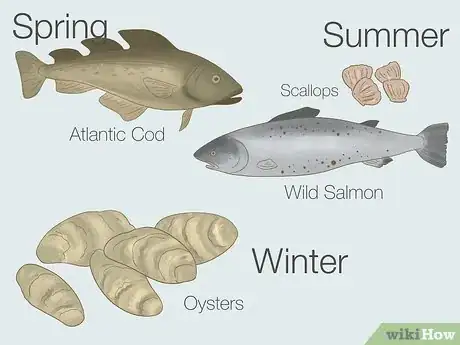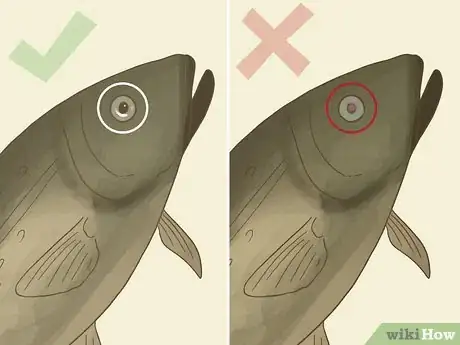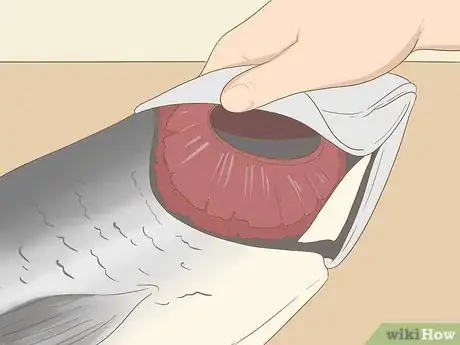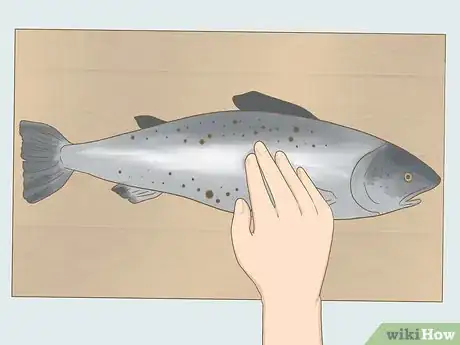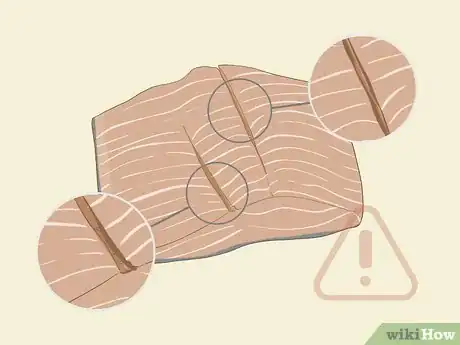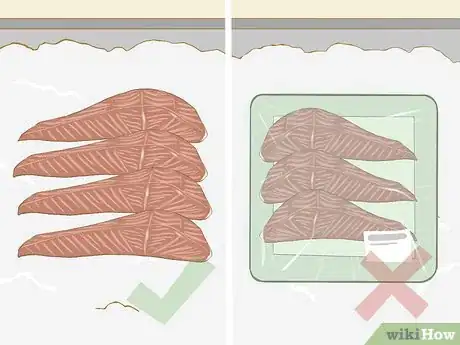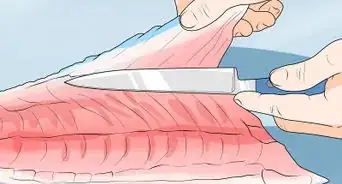This article was co-authored by Ollie George Cigliano. Ollie George Cigliano is a Private Chef, Food Educator, and Owner of Ollie George Cooks, based in Long Beach, California. With over 20 years of experience, she specializes in utilizing fresh, fun ingredients and mixing traditional and innovative cooking techniques. Ollie George holds a BA in Comparative Literature from The University of California, Berkeley, and a Nutrition and Healthy Living Certificate from eCornell University.
There are 7 references cited in this article, which can be found at the bottom of the page.
This article has been viewed 211,009 times.
Fresh fish makes a healthy and delicious meal. But if you've never bought fish before, you might be unsure how you can find the freshest options available. Luckily, there are clear signs to look for when buying fish. Any fresh fish doesn't have a pungent, "fishy" odor. On a whole fish, look for clear eyes, bright-colored gills, and firm skin. For fillets, look for discoloration or a slimy surface to indicate a spoiled fish. To ensure that your fish is of the highest quality, find a reputable fish market to do your shopping at.
Steps
Selecting Quality Whole Fish
-
1Pick fish that’s currently in season. Out of season fish have to be frozen, which takes away their freshness. Start by looking for options that are in season. If you aren’t sure where to start, asked the employee which fish was freshly-caught.[1]
- Most ocean fish are freshest in the late spring and summer. Some shellfish are fresher in the fall and winter.
- Other fish are caught year-round, so ask the worker which is the freshest option.
-
2Look for fish with clear, puffy eyes and avoid fish with cloudy eyes. When a spoiled fish dehydrates, its eyes are one of the first parts to deteriorate. A fresh fish has clear, shiny eyes that puff out. Check for these signs on any fish you’re considering.[2]
- Spoiled fish have cloudy eyes that are hard to see through. The eyes also start sinking as the fish dehydrates.
Advertisement -
3Get a fish with bright and shiny skin. A fresh fish’s skin will still be shiny and brightly-colored. The scales will remain metallic and reflect light clearly.[3]
- Any signs of discoloration or fading on the fish’s skin indicate that it is starting to go bad.
-
4Make sure the fish’s gills are bright red. A fresh fish still has blood in it, so its gills should be bright red. Lift up the gill flap near the fish’s head, or ask the employee to lift it for you. Underneath you’ll see the spongy gills. Look for a bright and uniform color on the gills to indicate the fish is still fresh.[4]
- Spoiled fish gills look darker red, more like a brick.
- Look for a uniform color on the gills as well. If there are different shades on the gill surface, the fish isn’t fresh.
-
5Push on the fish to make sure it feels firm. A fresh fish still has firm skin and muscles. If you lightly press into it, the skin should spring back quickly. If the skin feels mushy, the fish is starting to go bad.[5]
- Press in a few different spots. Fish sometimes bruise in different areas.
- A store employee may now want you touching the fish with your bare hands. In this case, ask them to push on it and watch to make sure the skin springs back.
Shopping for Fresh Fillets and Steaks
-
1Pick a fish fillet with no discoloration or darkening on its surface. A fresh fillet has a bright, uniform color across its whole surface. Any discolored or dark spots indicate that the fillet isn’t fresh. Do a visual check for any discoloration before buying a fillet.[6]
- Look especially on the edges of the fillet where it was cut. If the edges are drying out our changing color, the fillet is starting to go bad.
- Some fish have fibers or stripes on their skin that could look like discoloration. Check for other freshness signs if you aren’t sure.
-
2Avoid a fillet with cracks or tears on its surface. When a fillet starts going bad, its fibers tear and separate. A fresh fillet has a smooth, uniform surface. Look for this to find a fresh piece of fish.[7]
- Sometimes an uneven cut can look like tearing. The difference is that a spoiling fillet will look tight, which tears and flakes the skin. Look closer and see if the skin is actually flaking, or if there was just an uneven cut.
-
3Check for cloudy moisture indicating that the fish is spoiled. All fish have some moisture on their surface, but the moisture should be watery and clear. Slime is a sign that the fish is starting to rot. Cloudy or discolored sign is an even worse sign. Avoid any fish with milky slime on its surface.[8]
- If the employee lets you, run your finger across the fish. If the moisture is sticky and slimy, this isn’t a fresh fish fillet.
-
4Buy fish that are on ice, not wrapped in plastic. Just like whole fish, fish fillets should be kept out and on ice and only wrapped in plastic when they're sold. Fish wrapped in plastic at the store is generally not as fresh. Limit your choices to unwrapped fish packed on ice.[9]
- Fish in refrigerators is generally not as fresh. The fresh fish are kept on ice.
Finding a Reputable Fish Seller
-
1Visit a store that has a lot of customers for a high food turnover rate. A good indication of a quality food establishment is how busy it is. If a grocery store has a reputation for low-quality food, it probably won’t have many visitors. For fish markets specifically, a lot of customers means that fish gets sold quickly and fresh catches are brought in regularly. Spend a few minutes around a store or market you’re considering shopping at and see how many customers enter. If there aren’t many customers, consider shopping somewhere else.[10]
- Take the time of day into account. Most food stores are less busy during weekdays. If, however, it’s Saturday afternoon and there are no customers, then avoid this establishment.
- In larger supermarkets, the store could still be crowded if the fish isn’t good. Watch the fish counter specifically for a few minutes and see if anyone buys something. If some time goes by and customers seem to be avoiding the fish area, this is also a good indication that you should avoid it too.
-
2Avoid a store with an overly fishy smell. Fresh fish does not have a strong fish odor. Accordingly, neither should a store that sells fresh fish. If you walk into a market and are overwhelmed by the fishy smell, it means there is spoiled fish in the area. Don’t buy fish from this store.[11]
- Spoiled fish also has a mild ammonia smell. This odor also indicates that a market isn’t selling fresh fish.
- Fresh fish markets should smell more like salt water. There is some fish smell, but not a pungent, ammonia-like odor.
-
3Search the store for signs of poor sanitation like puddles and dirty floors. If a store looks dirty, you can assume that its food isn't the freshest. Take a walk through the aisles of a store before making a purchase and check its sanitation level. Puddles on the floor from melted ice, dirty floors, cleaning products near food, and unpleasant smells are all indications that a store does not follow sanitary procedures closely.[12]
- The fish area of any store should be neat and clean. Look for nicely-arranged and labeled fish. Fish pieces like heads and scales shouldn't be visible or near the fresh fillets.
- Look for a store with glass counters that you can see behind. A store that doesn't let you see behind its counters could be hiding unsanitary conditions.
-
4Check that all products are clearly labeled. In the US, federal law states that all food products must be clearly labeled. Check any fish market to see if all the products are labeled. If you can’t find basic information about the fish, consider shopping at a different store.[13]
- Common information on seafood labels include whether the fish was freshly-caught or farmed, and whether or not it was frozen. Very reputable dealers will include the date that the fish was caught as well.
- Sometimes labels are technically accurate, but still misleading. For example, “Fresh salmon, previously frozen” is technically true if the salmon was frozen right away. But a frozen fish will never have the taste of a freshly-caught one, so avoid a product like this if you only want fresh fish.
-
5Avoid a store where the employees don’t let you inspect the fish. If you request to inspect a fish you’re considering buying, employees should be happy to show you the fish and prove it’s fresh. If employees hesitate or won’t let you look at a fish further, they may be hiding the fish’s quality. Consider shopping at a different store where employees let you see the fish up close.[14]
- It’s reasonable that an employee would not want you touching the fish with your bare hands. However, they should still be willing to show you the eyes, gills, and skin to determine if it is fresh enough.
-
6Find a website to buy fresh fish online. If there isn't a fresh fish market near you, some websites specialize in delivering fresh fish packed in ice right to your doorstep. Search online for a reputable dealer with good reviews. Look for sellers that pack the fish as soon as its caught for the freshest options.[15]
- Pay close attention to shipping costs if you order fish online. Some of these expenses can be very high, depending on where you live and what you order.
- Don't hesitate to contact a seller if you have questions about their service. Ask when the fish is shipped out to determine how fresh their product is.
Community Q&A
-
QuestionIs fish safe for consumption if the gills are brown and the stomach smelly, but the flesh is bright and has no odor?
 Community AnswerNo - follow Julia Child's definition of a good fish: the eyes should be clear, the gills a deep red, and there should be no "fishy" smell present.
Community AnswerNo - follow Julia Child's definition of a good fish: the eyes should be clear, the gills a deep red, and there should be no "fishy" smell present. -
QuestionMy fish has turned sour. Is it safe?
 Community AnswerNo.
Community AnswerNo. -
QuestionWhat if the fish is alive?
 Community AnswerIf you want to eat it, you'll have to kill it.
Community AnswerIf you want to eat it, you'll have to kill it.
References
- ↑ https://www.esquire.com/food-drink/food/a13796323/buying-fish-seafood-guide/
- ↑ https://www.fda.gov/food/buy-store-serve-safe-food/selecting-and-serving-fresh-and-frozen-seafood-safely
- ↑ https://www.consumeraffairs.com/news/selecting-fresh-seafood-how-to-tell-if-fish-is-fresh-100416.html
- ↑ https://www.fda.gov/food/buy-store-serve-safe-food/selecting-and-serving-fresh-and-frozen-seafood-safely
- ↑ https://www.latimes.com/food/dailydish/la-dd-test-kitchen-video-tip-how-to-choose-fresh-fish-20140618-story.html
- ↑ https://www.fda.gov/food/buy-store-serve-safe-food/selecting-and-serving-fresh-and-frozen-seafood-safely
- ↑ https://www.latimes.com/food/dailydish/la-dd-test-kitchen-video-tip-how-to-choose-fresh-fish-20140618-story.html
- ↑ https://www.latimes.com/food/dailydish/la-dd-test-kitchen-video-tip-how-to-choose-fresh-fish-20140618-story.html
- ↑ https://www.seafoodhealthfacts.org/seafood-safety/general-information-patients-and-consumers/seafood-handling-and-storage
- ↑ https://www.cnbc.com/2018/09/21/a-fisherman-shares-his-best-tips-for-buying-fresh-fish.html
- ↑ https://www.latimes.com/food/dailydish/la-dd-test-kitchen-video-tip-how-to-choose-fresh-fish-20140618-story.html
- ↑ https://www.fda.gov/food/buy-store-serve-safe-food/selecting-and-serving-fresh-and-frozen-seafood-safely
- ↑ https://www.fda.gov/food/buy-store-serve-safe-food/selecting-and-serving-fresh-and-frozen-seafood-safely
- ↑ https://www.cnbc.com/2018/09/21/a-fisherman-shares-his-best-tips-for-buying-fresh-fish.html
- ↑ https://www.foodandwine.com/seafood/best-seafood-online-shop
About This Article
To buy fresh fish, look for a fillet or steak with a bright, consistent color across its whole surface. Avoid any fish with dark spots, cracks, or tears. If the edges of the fillet are drying out or changing color, it has started to go bad. If you’re buying whole fish, look for ones with clear, puffy eyes. Cloudy, sunken eyes are one of the first signs that a fish is going bad. Its skin should also be bright and shiny if it’s fresh. If you press down on the fish, its flesh should feel firm. Some types of fish are frozen before they’re sold, so if you’re looking for the freshest fish, ask an employee which ones have been freshly caught. For more tips, including how to find a reputable fish market, read on!
